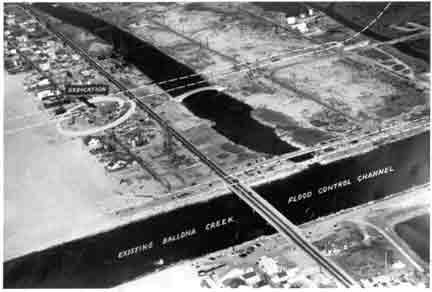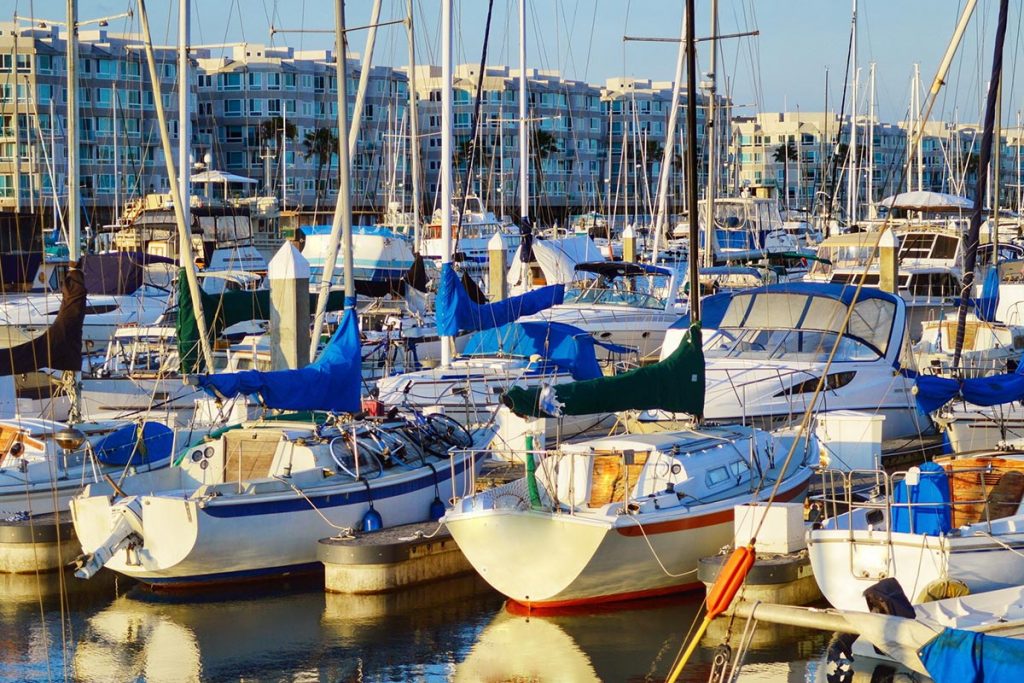MARINA DEL REY
HISTORY
MARINA HISTORY
A Vision for the Future
Marina del Rey has been a long time in the making. Construction of the jetties for the present entrance channel began in December 1957, but efforts toward a harbor at this location actually began some seventy years earlier, sponsored, ironically, by a railroad.
In 1887, a far-sighted man, named M.C. Wicks, organized the Port Ballona Development Company under the auspices of the Santa Fe Railroad. Wicks dreamed of developing the Playa del Rey estuary and inlet into a major commercial harbor to serve the Los Angeles area.
He managed to raise $300,000, all of which went for construction work over a three-year period. However, Wicks went bankrupt and the area was eventually taken over by duck hunters. Another quarter of a century passed without action, but the dream kept recurring.
In 1916, the U.S. Army Corps of Engineers reported to Congress that a new proposal to develop the Playa del Rey Inlet and basin as a major harbor was impractical.
But the Dream Refused to Die
Twenty years later, in 1936, Congress authorized reconsideration of the negative 1916 report and the County Board of Supervisors ordered another study in 1937. This time there was competition, and the decision went to San Pedro, where major expansion had been approved to form the present Los Angeles Harbor.
From this point on, the dream focused with increasing clarity on a harbor for small craft.
World War II caused a temporary halt to planning, but on September 7, 1949, the U.S. Army Corps of Engineers submitted a report indicating the feasibility of construction of a pleasure craft harbor for 8,000 boats at a total estimated cost of $23,603,000.
Financing and Construction Begin
In 1953, the County Board of Supervisors sponsored State legislation which eventually granted the County a $2 million loan from State tidelands oil revenues to assist in purchase of the new harbor site.
In 1954, President Eisenhower signed Public Law 780, making the Marina del Rey harbor an authorized federal project and planning moved into high gear. The federal commitment, however, was limited to the “main navigational features” and involved a 50-50 sharing of these costs by the local sponsor; in this case, the County of Los Angeles.

Breakwater Needed to Protect the Harbor
Meanwhile, the results of the model study indicated a requirement for a permanent off-shore breakwater. The County Board of Supervisors promptly appropriated $2.1 million of the estimated cost of $4.2 million for this project as the sponsoring agency’s share, and a concerted effort by the County’s legislators in Congress was successful in securing the matching Federal appropriation in the 1963-64 budget.
Construction of the breakwater began on October 15, 1963, and was completed in January 1965. The dispatch with which this major point project was planned, funded and constructed reflected a healthy working relationship between County and Federal governments and particularly indicated the effective representation enjoyed by the County in Congress.
Opening Day Comes in 1965
Marina del Rey successfully surmounted its major development problems and was progressing steadily toward complete fulfillment of its destiny. Formal dedication of the Marina del Rey Harbor was held on April 10, 1965.
PUBLIC FUNDS
Public funds invested in the initial project included:
Federal Government
$4.6 million for 50% of cost of navigation features (jetties, breakwater, dredging main channel)
State Government
$2 million, which consisted of a loan from tideland oil revenues toward acquisition of site (now repaid out of project revenues)
County Government
$15.89 million for land acquisition, 50% of cost of main navigation features, more roads, administrative facilities and Coast Guard Base
Motor Vehicle Fund
$775,000 for perimeter roads
Additional Funding
In addition, proceeds from the public sale of revenue bonds totaled $13 million, for bulkheads, sewers and underground utilities, dredging side basins, landscaping, initial costs of operations and bond service
TOTAL COST
$36.25 million for land, construction, initial operation and bond service
TODAY'S MARINA

Today, Marina del Rey is an indispensable social, environmental and economic success, and has become a role model for other urban marinas throughout the world.
As the Marina heads into the next century, considerations for future planning and design are underway.
Marina del Rey will never be thought of as a finished product, but instead as a constantly evolving Marina “new town” with an inherent capacity to accept change.
Currently, the County continues to strive for an optimum balance between public and private interests, as economic and recreational needs reinforce the Marina’s role as a multifunctional activity center for the Los Angeles metropolitan area.
(Reprinted by the Marina del Rey Convention & Visitors Bureau, from Los Angeles County’s “The History of Marina del Rey”.)
MARINA DEL REY HISTORICAL SOCIETY
Marina del Rey Historical Society
4030 Del Rey Avenue
Marina del Rey, CA 90292
310-822-9344
Marina del Rey Historical Society Gallery
Fisherman’s Village
13737 Fiji Way C-3
Marina del Rey, CA 90292
310-701-1073
The Marina del Rey Historical Society was founded in 2007 to collect and preserve historical documents, artifacts, publications, photographs, data and information relating to the development of Marina del Rey and its future.
As historical data is collected into exhibits and retrievable electronic outreach, the Marina del Rey Historical Society hopes to keep the past alive for community pride as well as create the data base for a continuing historical record of Marina del Rey and the surrounding area. Currently our collection includes Marina del Rey, Playa del Rey, the Howard Hughes Airfield (Playa Vista), Venice, Ocean Park, Santa Monica, LAX (Mines Field) and San Pedro.
Since our collection is electronically filed, personal contributions (photographs, printed material, documents, etc.) can be scanned to our files and the originals returned to the donor. Credit for the contribution will be listed and included in the captions.
STATISTICS
Public Recreational Facilities
Burton W. Chace Park; Admiralty Park; Marina “Mother’s” Beach; regattas, crew races, boat parades, sailing races, park concerts, harbor cruises; handicapped swim ramps, children’s playground, boat rentals and sailing instruction, South Bay Bike Trail (part of 20-mile coastal bicycle path), north jetty promenade and view piers, vista points, fishing docks, Marina Information Center, County Library with large nautical section.
Boating Facilities
Marina del Rey harbor features facilities and amenities such as boat slips, boat launching areas for hand-carried or trailered boats, dry boat storage, yacht clubs, repair yards, fuel dock & pump-out stations, live bait, charters, transient boat docks, and boat sales and brokerages. The number of boat slips varies, from 4,500 to 4,800, as anchorages are renovated and docks reconfigured on an ongoing basis.
Civic Contribution
Community with current population of 10,000; more than 200 individual businesses provide 6,000-8,000 jobs; taxes generated by leases provide significant tax revenue for County, City schools, special districts, etc.; direct freeway access via Marina Freeway (Route 90).
Physical Characteristics
804-acre site (403 water, 401 land); 2,340 feet of off-shore breakwater; 2 miles of main channel (1,000 feet wide), 3 miles of side basins (600 feet wide), 8 miles of concrete bulkhead; 6 miles of landscaped roadways, and all utilities underground.
